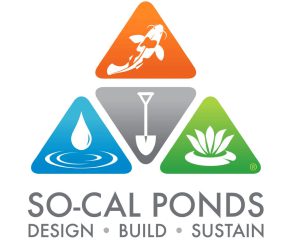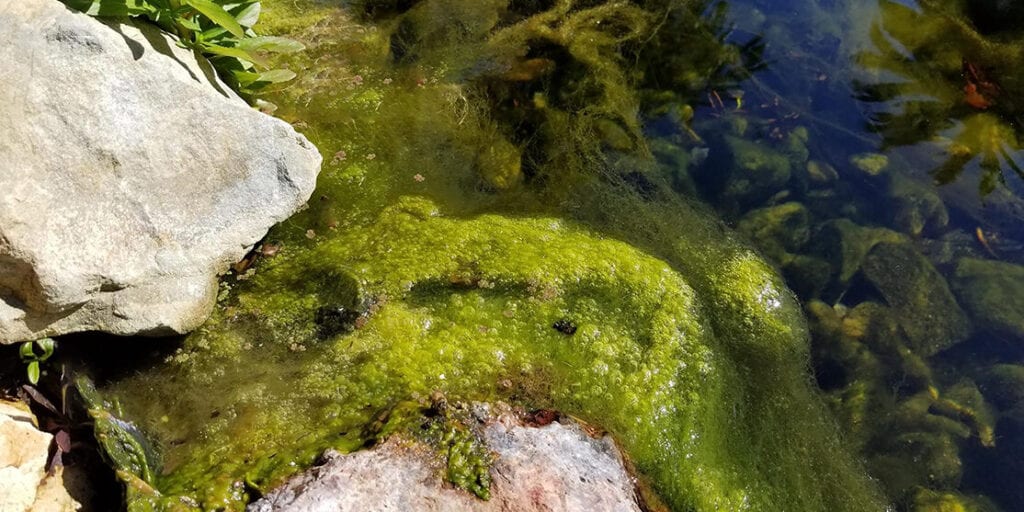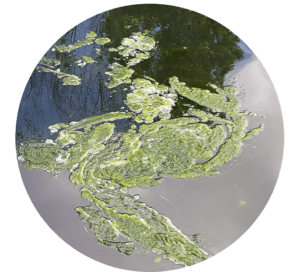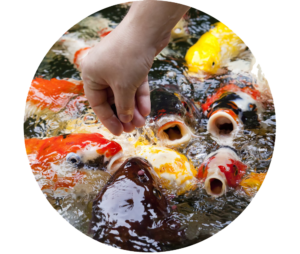- Home
- About Us
- Landscape
- Ponds & Water Features
- Portfolio
- Blogs
- Resources
- Contact Us
close


Many pond owners at this time of year find themselves wondering, “it’s cold outside, why is there algae in my pond?” It’s common belief that when it’s cold algae shouldn’t grow. Although temperature does play a role in the growth of algae, there are many other variables that also contribute. If a pond isn’t balanced,
During this time the pond is adjusting to the environment and balancing itself out. With the biological portion of the pond dormant nothing is there to keep it in “check”. Since the bacteria is dormant, Mother Nature grows the algae to help keep it safe until the bacteria levels rise once the water temperature rises above 60 Degrees F.
Algae is a natural occurrence in any body of water and even more so in an enclosed backyard pond or water garden. Algae is Mother Natures way of cleaning the water… It’s your pond natural filtration system.
As the ambient temperature cools in the fall and into winter, so does the water temperature of your pond. During the cold months of winter the pond slips into a dormant state and not much is happening. The fish’s metabolism slows, their food intake reduces, the beneficial bacteria in the pond slows and eventually goes dormant. During the coldest months of winter the pond is pretty inactive and some states possibly under several inches of ice. When the days start to get longer and the sun shines brighter everything begins to wake up.
Flowering plants start to grow, trees start to bud out with new leaves and the pond starts to become active again. You may notice your fish are starting to become active and may look as if they want to start eating again. However, you must remember if the water temperature is still below 55 degrees F, then the pond is still considered dormant therefore your fish’s metabolism is too slow to handle food at this time. The beneficial bacteria that normally keeps the pond balanced will not become active until the water temp is constantly above 55 degrees F. As everything else in your yard starts to grow, so does the algae in your backyard pond. The algae in your pond is the only thing that is working to keep your water balanced.
For whatever reason, there is a stigma of algae being bad or a negative thing in your pond. Although some algae can be bad, normal pond algae is NOT. The big box pet retail stores will tell you differently but with almost 20 years of experience, we can assure you algae is not a bad thing. Algae acts like a sponge for the deadly ammonia in your koi pond. Algae needs nutrients to grow and reproduce, adding algae treatments (algae killer) to the pond will prevent the algae from growing, while allowing organic nutrients to build up. Once an algae product has been added to the pond, the entire chemistry of the pond has been altered and will now be dependent on that product the rest of the pond season.

A healthy pond will have a nice layer of 1/2″ – 2″ long dark green algae growing on the surface of the pond. This includes the waterfall, the rocks and the bottom surface of the pond. During the late winter or early spring you can expect the algae to grow a little longer until the beneficial bacteria kicks in and does its part to balance the pond. We tend to let the algae grow as it will during the early spring months and only treating it once it become a nuisance. As it begins to die off or slow in growth we will remove the algae from the pond. Leaving dying algae in the pond will only feed the cycle and encourage new algae to grow.
During this time the pond is adjusting to the environment and balancing itself out. With the biological portion of the pond dormant nothing is there to keep it in “check”. Since the bacteria is dormant, Mother Nature grows the algae to help keep it safe until the bacteria levels rise once the water temperature rises above 60 Degrees F. if the water temperature is still below 55 degrees F, then the pond is still considered dormant therefore the beneficial bacteria that normally keeps the pond balanced will not become active until the water temp is constantly above 55 degrees F. As everything else in your yard starts to grow, so does the algae in your backyard pond. The algae in your pond is the only thing that is working to keep your water balanced since the bacteria is dormant.
This could mean there are too many leaves in the pond or not enough filtration
Algae feed on byproducts of decomposing organic debris, like phosphorous and nitrogen, in the water. During the warmer months, natural bacteria would typically break down these nutrients, leaving little food for the organisms. But in the cooler months, those bacteria go dormant. That means more food for the algae, and a population explosion.

You probably know that ponds need to be aerated. A lack of oxygen can cause stagnation problems. Stagnant water aides algae species that grow well in low oxygen conditions. The end result is often a very foul odor. All pond life suffers in low oxygen. If you have fish they may be seen gasping at the surface. This is a sign of seriously low oxygen levels. To increase oxygen, add aquatic plants to help filter and oxygenate the pond. In addition to aquatic pond plants, an aerator, which is a device that increases the oxygen level in a pond, discourages algae growth and reduces the amount of available phosphorus in your pond water. Adding an air pump will add movement to the pond. Stagnant ponds are problematic, and water movement discourages algae growth.
In southern California, we have all been relieved by the recent rainfall. However, this could affect your ponds nutrient levels resulting in algae. When runoff carries excess nitrogen and phosphorus into a pond, or when heavy rainfall causes additional runoff, an algal bloom becomes possible. Common sources of nitrogen and phosphorus in runoff are manure and agricultural fertilizers. Soil erosion can also contribute to algae growth, because phosphorus is bound up in soil particles.
Luckily there are many ways to control algae depending on how long you are willing to wait for the algae to clear.
We highly recommend the organic time tested method of letting the algae bloom, peak, and die; this take time and patience. You can practice manual removal as well and get in there to start pulling it.
Remember to remove any excess organic debris from the pond. And keep your eyes on the nutrient levels of the pond. Increase, supplement, improve filtration to process nutrients more efficiently. Easy to use test kits are available and necessary to analyze your pond water condition. Key tests and acceptable results are: Ammonia = 0, Nitrate=0, Oxygen = 80% + saturation, pH 6.5-8.8 with minimal daily fluctuations, and hardness = >80.
Have an experienced pond company perform a cleanout of the pond. Water changes can help reduce nutrients and growth rate of algae.
Provide more oxygen to your pond with a simple air pump and diffuser is very effective, as well as adding more complex aquatic plants to out-compete algae for nutrient resources.
It should be mentioned to be extremely careful with “overnight solutions”, sometimes fast acting changes are not the best thing for aquatic life. Remember, Algae is a natural occurrence in any body of water and even more so in an enclosed backyard pond or water garden.